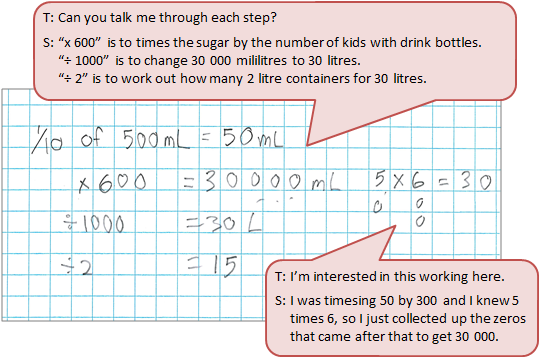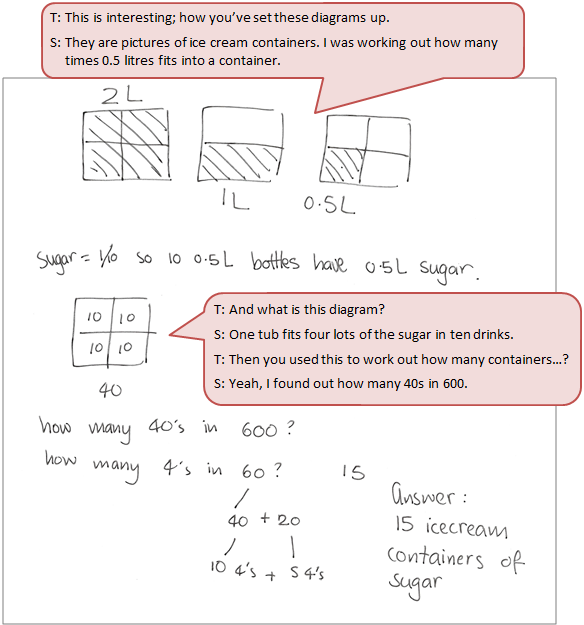The purpose of this activity is to engage students in using mathematical strategies to solve a measurement problem in context.
This activity assumes the students have experience in the following areas:
- Recalling basic facts for multiplication and division.
- Applying multiplicative strategies to calculate mentally, with pencil and paper, and digitally.
- Working with common metric units of measurement.
- Understanding the meaning and purpose of pre-fixes in the metric system, e.g., centi- means one hundredth.
The problem is sufficiently open ended to allow the students freedom of choice in their approach. It may be scaffolded with guidance that leads to a solution, and/or the students might be given the opportunity to solve the problem independently.
The example responses at the end of the resource give an indication of the kind of response to expect from students who approach the problem in particular ways.

A year 6 class is studying healthy foods and wants to show, at a school assembly, how bad sugary drinks are.
The class has found out that sugar makes up one tenth of the volume of a popular soft drink.
The class plans to ask each of the 600 students in the school to bring in their drink bottles filled with the same amount of water as a 500 mL (half a litre) soft drink bottle holds. This is so that the class can tell the school it is just as well they have water in the bottles because, if they had a soft drink...what a huge lot of sugar they would all be consuming.
They will have on stage, the volume of sugar that would be in all of the drink bottles if they contained the sugary soft drink rather than water. The sugar will be placed in 2 L icecream containers.
How many icecream containers will they need?
The following prompts illustrate how this activity can be structured around the phases of the Mathematics Investigation Cycle.
Make sense
Introduce the problem. Allow students time to read it and discuss in pairs or small groups.
- Do I understand the situation and the words? (Students may not be familiar with the meaning of volume as amount of 3-dimensional space. Diagrams may support the idea of 10% by volume of soft drink is sugar.)
- What do you know and what don’t you know? (Students may not know about 2L icecream containers and may want to investigate the size of them.)
- Do I understand the measurements in the problem? (Students need to know that 1 mL means ‘one thousandth of a litre’ and is equivalent in volume to 1 cm3.
- What will my solution look like? (The solution will be the total number of icecream containers full of sugar. The answer must be supported with evidence.)
Plan approach
Discuss ideas about how to solve the problem. Emphasise that, in the planning phase, you want students to say how they would solve the problem, not to actually solve it.
- Where will I start? What do I need to do first?
- What tools will be useful? (Drink bottle, icecream containers, place value blocks and measuring cylinders will all support students to understand the meaning of the measurements involved.)
- What information might I need to look up? What information do I already know?
- What calculations will I probably have to do? Is a calculator needed, or can I calculate in other ways?
- Do I have a sense of possible answer? What do I expect? What answer would surprise me?
Take action
Allow students time to work through their strategy and find a solution to the problem.
- Am I recording my workings in a systematic way so others could follow them?
- Is my strategy working or do I need to change tack?
- Does my answer seem correct? Does the amount of sugar seem reasonable compared to the amount of soft drink?
- Does the order I calculate in matter? Are there other ways to solve the problem?
- What solutions have other students got? Do their solutions match mine? Why, or why not?
Convince yourself and others
Allow students time to check their answers and then either have them pair share with other groups or ask for volunteers to share their solution with the class.
- What is the solution? Can I show that the solution is correct? How?
- Is my working clear for someone else to follow?
- How would I convince someone else I am correct?
- Could I have solved the problem in a more efficient way?
- What connections can I see to other situations, why would this be?
- Which ideas or tools worked well in my investigation?
- What could I try differently next time?
- What maths did I use and learn?
Examples of work
Work sample 1
The student uses multiplication and division to find the number of covert (cm3) of sugar in 600 mL of soft drink. They multiply the unit rate per student by 600 to get the total volume of sugar. Finally, they covert mL to litres and divide to find the number of icecream containers needed.
Click on the image to enlarge it. Click again to close.
Work sample 2
The student uses a diagrammatic strategy to represent the quantities. They use rounding to 0.5L and multiplication to get a unit rate of 40 student bottles of sugar to 1 icecream container. They divide 600 by 40 to get the correct answer of 15 icecream containers.

